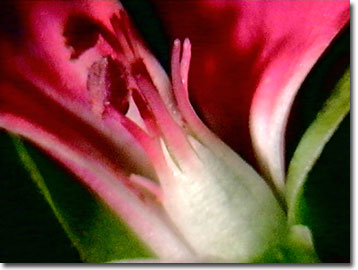Reflected Light Digital Image Gallery
Common Garden Geranium (Pelargonium x hortorum)
A favorite of home gardeners and horticulturists, the common garden geranium (Pelargonium x hortorum) is also known as the zonal geranium, based on the distinct bands or zones on their ornamental leaves. Whether single, double, or in clusters, the flowers of the geranium vary in coloration with red, pink, salmon, and white available in cultivars.

View a second image of a common garden geranium (Pelargonium x hortorum).
Bred and domesticated from wildflowers and herbaceous perennials, common geraniums are some of the most popular flowering plants, whether grown outdoors or as houseplants. Dozens of cultivars have been developed from seeds and from vegetative cuttings. Indoors, the geranium prefers 65 to 70 degrees Fahrenheit during the day and cooler nights at 55 degrees Fahrenheit. Ideally, well-drained soils and moderate to bright light will make the zonal geranium flower for months.
Common garden geraniums and some of their Pelargonium relatives are known by herbalists as American cranesbill or alum root. The dried rhizome and leaves of the wild geraniums are used for their styptic and astringent properties, and also as a gargle and for diarrhea. Geraniums are rich sources of tannic and gallic acid that provide some of their attributed medicinal properties. A number of the related wildflowers and herbs in the geranium family (Geraniaceae) feature leaves that are edible, whether raw or cooked. Of the over 700 varieties of geranium, a few produce essential oils having a green sweet scent that is sometimes rosy or minty, and is used to promote skin healing and moisturizing.
Wild geranium flowers are used by plant taxonomists and botany classes to illustrate flower structure including the petals, sepals, and carpals. The simple, dry dehiscent fruit of the geranium is a prime example of a schizocarp and when ripe, breaks into single-seeded sections. Derived from the ancient Greek word for crane, geraniums were so named because the long beak of the fruit was thought to resemble the bird's distinctive beak. Interestingly, the current genus name Pelargonium is also derivative of the ancient Greek word for stork, "pelargos". Carl Linnaeus, the eighteenth century biologist known as the father of modern plant and animal classification, caused some confusion in naming when he combined several of the species now classified as Pelargonium with true botanical geraniums, which are now placed in the separate genus Geranium.
Contributing Authors
Cynthia D. Kelly, Thomas J. Fellers and Michael W. Davidson - National High Magnetic Field Laboratory, 1800 East Paul Dirac Dr., The Florida State University, Tallahassee, Florida, 32310.
BACK TO THE REFLECTED LIGHT IMAGE GALLERY
BACK TO THE DIGITAL IMAGE GALLERIES
Questions or comments? Send us an email.
© 1995-2025 by Michael W. Davidson and The Florida State University. All Rights Reserved. No images, graphics, software, scripts, or applets may be reproduced or used in any manner without permission from the copyright holders. Use of this website means you agree to all of the Legal Terms and Conditions set forth by the owners.
This website is maintained by our
Graphics & Web Programming Team
in collaboration with Optical Microscopy at the
National High Magnetic Field Laboratory.
Last Modification Friday, Nov 13, 2015 at 01:19 PM
Access Count Since September 17, 2002: 8766
Visit the website of our partner in introductory microscopy education:
|
|
